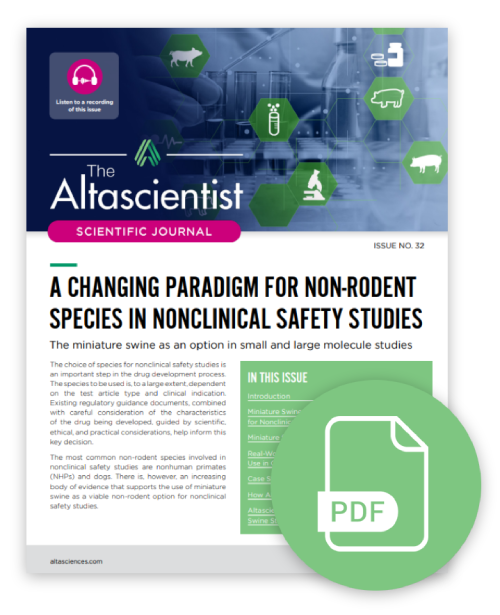ISSUE NO. 32 — A Changing Paradigm for Non-Rodent Species in Nonclinical Safety Studies
The choice of species for nonclinical safety studies is an important step in the drug development process. The species to be used is largely dependent on the test article type and clinical indication. Existing regulatory guidance documents, combined with careful consideration of the characteristics of the drug being developed, guided by scientific, ethical, and practical considerations, help inform this key decision.
careful consideration of the characteristics of the drug being developed, guided by scientific, ethical, and practical considerations, help inform this key decision.
The most common non-rodent species involved in nonclinical safety studies are nonhuman primates (NHPs) and canines. There is, however, an increasing body of evidence that supports the use of miniature swine as a viable non-rodent option for nonclinical safety studies.
In Issue 32 of The Altascientist, we take a deep dive into the benefits of miniature swine as a research model in your nonclinical studies:
- Introduction to miniature swine in preclinical testing
- Miniature swine size considerations
- Real-world examples for miniature swine use in clinical development
- Species selection criteria and processes
- Four case studies
The Case for Using Miniature Swine in Nonclinical Safety Studies
Initially used for medical research in Europe, miniature swine were introduced to the U.S. in the 1980s. Their use now extends to many therapeutic areas due to an increasing body of knowledge supporting their appropriateness for nonclinical safety studies.
The U.S. FDA Redbook recommends the use of miniature swine for different types of toxicity testing. Redbooks IV.C.3.b provides direction on short-term toxicity testing, while IV.C.4.b addresses subchronic toxicity studies. IV.C.5.b is on the topic of one-year toxicity studies. All list the miniature swine as a preferred species.
For small molecule programs, the primary driver for non-rodent selection is metabolism and absorption. The two main components for metabolism and absorption are cytochromes and transporters, and these have been found to have 70% similarity between miniature swine and humans. The gastrointestinal (GI) tract has the most metabolic activity outside of the liver, and the physiology of the miniature swine GI tract is similar to human (pH of stomach, small, and large intestine; salivary amylase; rate of gastric emptying, and GI transit time).
For programs where the test article is a biologic, there is a long-held view that NHPs are the default species, and miniature swine were not even considered as an option. However, data is emerging that challenges this belief. The first step in determining whether the miniature swine is an option for biologic programs is to understand the conservation of the target across the potential nonclinical safety species.
While many programs involve specific epitopes with limited conservation across the species, there are programs where the target is highly conserved, and the miniature swine is a viable option.
Explore all issues of The Altascientist in our Resource Center. And don’t forget to subscribe to “The Altascientist: Audiobooks” on Spotify, Apple Podcasts, or wherever you get your audio content.
Download publication